Racing in F1 is the maximum but at Hesketh it is worth more. In the most beautiful moment in the history of Formula 1, in the most glamorous team ever and possibly in the best looking F1 cars ever.

Lord Hesketh, Susan Miller and James Hunt.
Women, class, engines and champagne... flowing.

Lord Hesketh shows a 'cocktail' message to Ian Scheckter during Austrian Grand Prix 1974. Credit: unknown.
And the pilot was James Hunt, one hell of a driver, the 007 of Formula 1, easily the greatest character among F1 drivers. Sex, drug and fast cars were his legend. A real playboy with only two loves, woman and cars. The Hesketh era......, champagne and shagging. Hunt was a top shagger and top driver too!
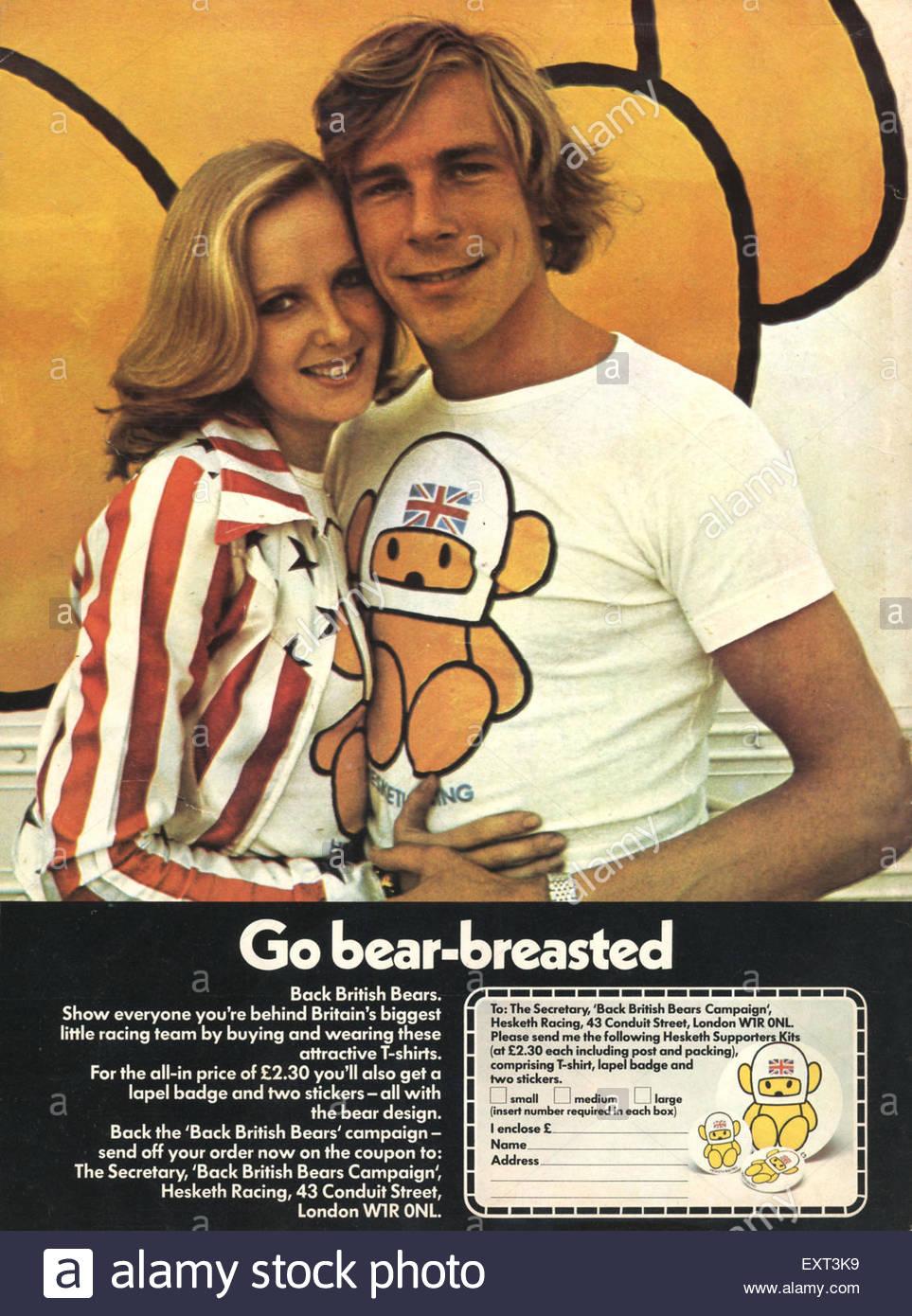
1970s Uk, Hesketh racing magazine advert.
We have a bit of a soft spot for the 1970s, and we get quite nostalgic over wedgy sports cars, grainy BBC comedies, Scalextrics and other retro playthings. But we get especially misty eyed over anything from this golden age of F1 when our boyhood heroes – Hunt, Lauda, Fittipaldi et al – did battle.

James Hunt and Barry Sheene.

James Hunt and Barry Sheene.
There were two very handsome and charismatic motorsport world champions: on two wheels was the enigmatic Barry Sheene and on four the gentleman playboy James Hunt. These two instantly hit it off and soon became good mates, sharing a love of fast machines, good living and (allegedly) a particular peccadillo for air hostesses which meant they nearly always had their teams book into hotels near to the major airports;

1976 Japanese Grand Prix. Fuji, Japan. 22nd - 24th October 1976. James Hunt (McLaren M23-Ford), 3rd position, in the paddock with girls, portrait. World Copyright LAT.

James Hunt (McLaren-Ford) and pit babes / grid girls before practice for the 1976 Japanese Grand Prix at Fuji Speedway. Photo: Grand Prix Photo.
Hunt in particular, with Sheene as his wingman, was rumoured to have fiddled with more British Airways ‘undercarriage’ than the entire Gatwick ground crew. What a line .... absolutely brilliant stuff.

Jarno Saarinen and his inseparable wife Soili Karme on the Monza circuit in 1971.

They were household names on a level that today's crop of beige drivers and riders couldn't even comprehend.

James Hunt (1947 - 1993) with his fiancée, fashion model Suzy Miller, during the 1974 British Grand Prix at Brands Hatch, UK, 20th July 1974. Photo by Evening Standard/Hulton Archive/Getty Images.
But, while Sheene took 500cc and 750cc World Motorcycling Championships in the mid ‘70s with backing from the biggest and most professional Japanese works teams, Hunt’s rise to F1 stardom is one of the greatest tales of plucky British underdogs, English eccentrics and devil-may-care spirit that has ever been told. Today's F1 is far too clinical........

Formula 1 girls, Brazil, 1989, Rio de Janeiro.
Bring back real drivers, the smell of Castrol "R", cheap burgers, warm Worthington E beer and girls in Denim hot pants at all GP meetings!

The mechanic in the pits were wearing a sweater, jeans and trainers.

Italian mechanics working on a Ferrari 312 under pressure, with an antipasto platter, bottle of red wine and jovial conversation.
It was very low key back then, no team jumpsuit like these days.
Hunt's Silverstone none championship race was what got people interested in F1 all those years ago and, although they still watch it, it has lost the 'magic' it had in the 70's, and earlier.

Hesketh will always be remembered for the most charming F1 livery of all time. The most British name of F1 team ever.
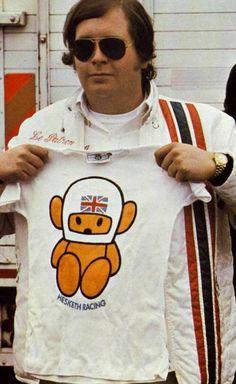
Lord Hesketh.

James Hunt with his fiancée, model Suzy Miller in the run-up to the British Grand Prix, UK, 17th July 1974. Miller is wearing a Hesketh Super Bear t-shirt. Photo by Victor Blackman/Express/Hulton Archive/Getty Images.
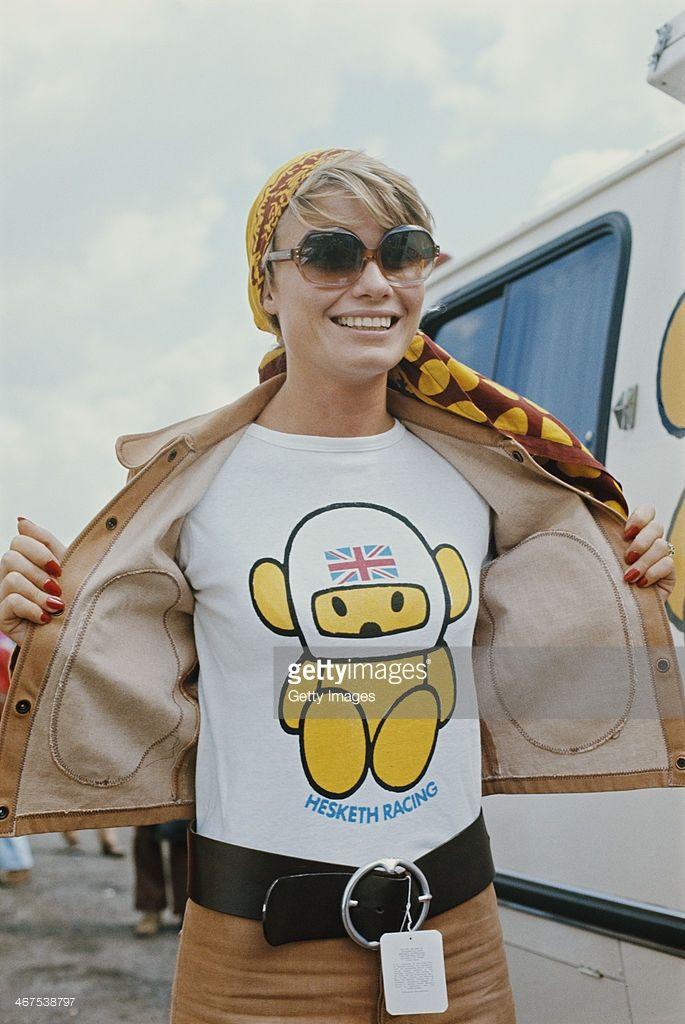
Suzy Miller, wife of James Hunt, driver of the Hesketh Racing Hesketh 308 Ford Cosworth DFV V8 shows her Hesketh Super Bear T shirt during the British Grand Prix on 20th July 1974 at the Brands Hatch circuit in Fawkham, Great Britain. Photo by Michael King/Getty Images.
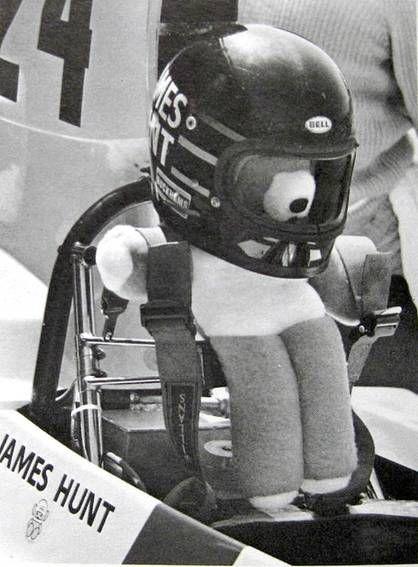
And that teddy bear logo - best F1 logo ever, no debate. This is how all F1 teams should be. This is what F1 should be all about. Legends.

Lord Hesketh with Rupert Keegan and ladies from the adult magazine, Penthouse, the main sponsor of the Hesketh team alongside Rizla, at the presentation of Hesketh 308E in 1977. Credit: unknown.
“Men love women but, even more than that, men love cars.” Lord Hesketh

“We signed the only contract we ever had with him [James Hunt] on the back of a beer mat in a café in Belgium. I’ve always been rather pleased and proud of that.” Lord Hesketh describes contract signing procedures in F1 in the 1970s

There is no better example of an ‘against all odds’ story than the 1974 Hesketh Racing F1 team.

Champagne was always flowing at Hesketh Racing. Credit unknown.
Anti-establishment, unconventional, independent, partial to champagne-fuelled shenanigans. Hesketh Racing was all of these things and more.

With the maverick James Hunt at the wheel of the fabled 308 F1 car and the extravagant 23 year old Lord Hesketh at the helm, ‘the biggest little racing team in the world’ captured the public’s imagination.

Lord Hesketh and James Hunt.
Scorned by the established teams who considered them a bunch of public school boy amateurs with no place in the sport, the Hesketh squad audaciously challenged the big boys in their own back yard.

Lord Hesketh became famous for his 'work hard, play hard' ethos. Credit unknown.
They partied as hard as they raced.

Champagne flowed in abundance.



The stables at Lord Hesketh's country house 'Easton Neston', built in 1702, were converted into workshops.

Hesketh 308 3.0 V8. Photo by RetroGP. Source UK Racing History.

1975 308B.

Hesketh 308B Ford V8 (n. 24 James Hunt). Source F1 Old and New.
It was here that, yet unknown (then headed for a big career), genious designer Harvey 'Doc' Postlethwaite, who claimed he only agreed to join the team during a moment of weakness after... 'they got me drunk' ..., created what is now regarded as one of the most iconic F1 cars of all time. The Hesketh 308.

Ronnie Peterson took the victory for Lotus at Watkins Glen in 1973, but James was on Peterson’s tail right to the flag to take a career-best second, after only 10 starts, in the Hesketh March. It also looks suspiciously like a cartoon of milk in James's hand, which was a well-known beverage of choice for him. Credit: unknown.

Lord Alexander Hesketh outside his new motorhome at the 1974 Monaco Grand Prix. Photo by Lat Images.

1974 Monaco Grand Prix, Monte Carlo, Monaco. 23rd - 26th May 1974. James Hunt (Hesketh 308-Ford), retired, in the pit lane with Beaky Sims and Lord Hesketh, portrait. World Copyright: LAT Photographic.

A view down the pit lane with James Hunt, Hesketh 308 Ford, heading out on track and Tom Belso, Williams FW02 Ford in the foreground.
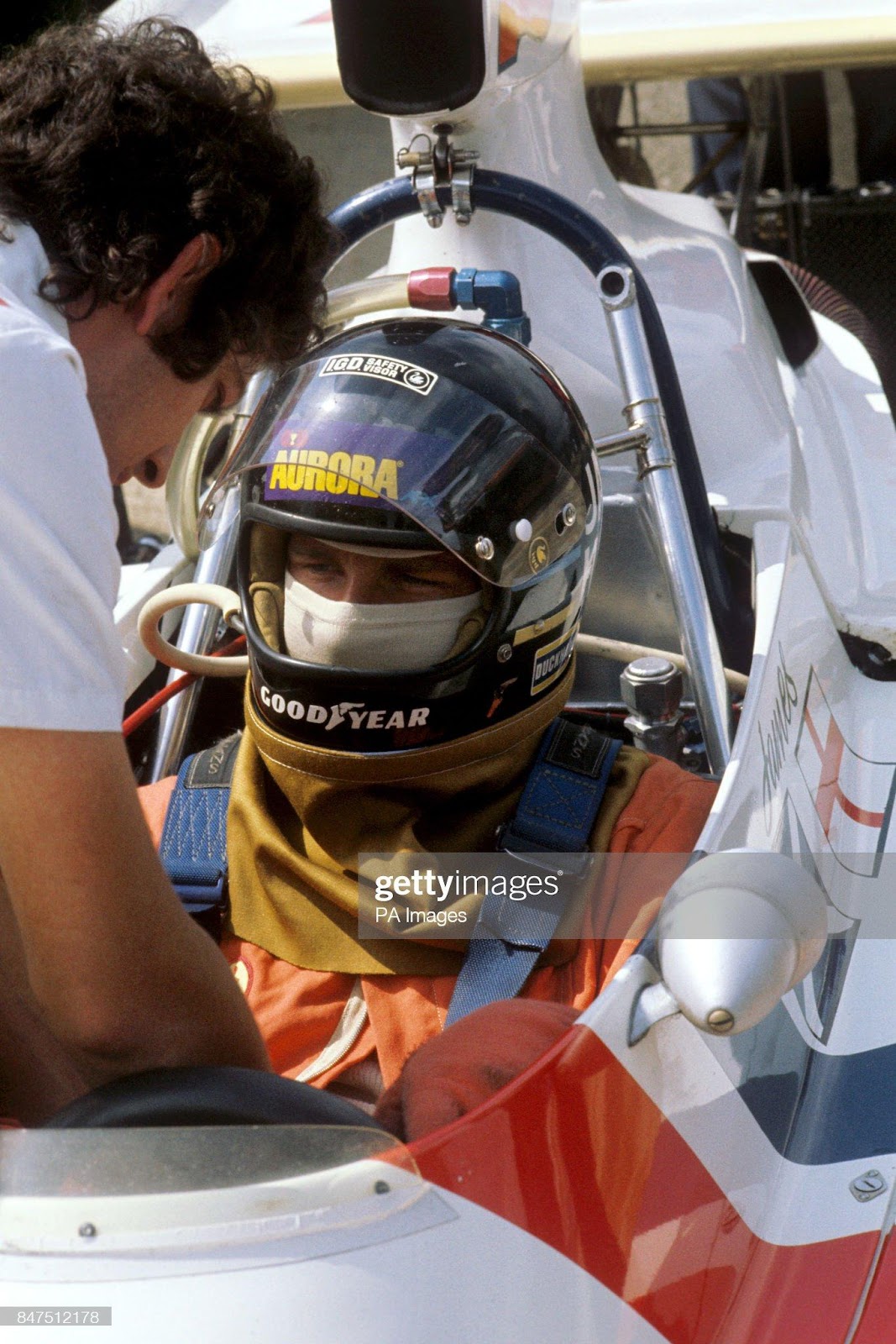
James Hunt, Hesketh Ford, in 1975. Photo by PA Images via Getty Images.

James Hunt, Hesketh, at the 1975 British Grand Prix.

The start of the 1975 French Grand Prix, held at Paul Ricard. Source GTX Forums.
Hesketh Racing, the most trendy team of the Circus, was a F1 constructor from the United Kingdom, which competed from 1973 to 1978 in 52 World Championship GP, winning one and achieving eight further podium finishes. Its best placing in the World Constructors' Championship was fourth in 1975.

Lord Hesketh and James Hunt.
Hesketh was notable for giving James Hunt his F1 debut and he brought the team most of its success. Alan Jones also began his F1 career in a privately entered Hesketh.
Good Lord... The remarkable tale of Hesketh Racing. 19 January 2014. By Classic Driver.

Lord Thomas Alexander Fermor-Hesketh.
To give him his full name, Lord Thomas Alexander Fermor-Hesketh, 3rd Baron Hesketh, was an eccentric figure from the world of F1 racing in the 1970s.

The youngest peer in England, seven year old Thomas Alexander Fermor-Hesketh, 3rd Baron and 10th Baronet Hesketh, with his pony 'Blossom' at his ancestral home, Easton Neston in Northamptonshire, in 1957. Credit Slim Aarons.
When you succeed to a baronetcy shortly before your fifth birthday and inherit a 3,200-acre estate, complete with its own racecourse, the odd village and Hawksmoor-designed stately home, one's idea of 'normal' must be somewhat different from that of most other people...

Fast forward a number of years and Lord Hesketh had traded his horse for horsepower, founding his own motor racing team Hesketh Racing and motorcycle manufacturer, Hesketh Motorcycles. Credit Lichfield Archive.

Lord Alexander Hesketh leaning on the Hesketh V1000.

Lord Hesketh with a Hesketh V1000 motorcycle at Easton Neston. Credit unknown.

For a man who once led a maverick F1 team, his office, with its piles of business documents and signed photograph of Margaret Thatcher, seems the very picture of respectability. 'You have to remember how young I was,' Hesketh explains. 'I was 22 when I started in F1. By 25 I'd already quit.'

The Hesketh Team and support vehicles photographed at Easton Neston. Credit: unknown.

The stables at Easton Neston, built in 1702, were converted into the Hesketh Racing workshops. Source RetroGP.

Lord Hesketh’s latest car now lies silent in the closed racing stable at Towecester. Photo by James Gray/ANL/Shutterstock.
Having dropped out of school to pursue his interest in cars, Lord Hesketh launched his own team, with his own money.

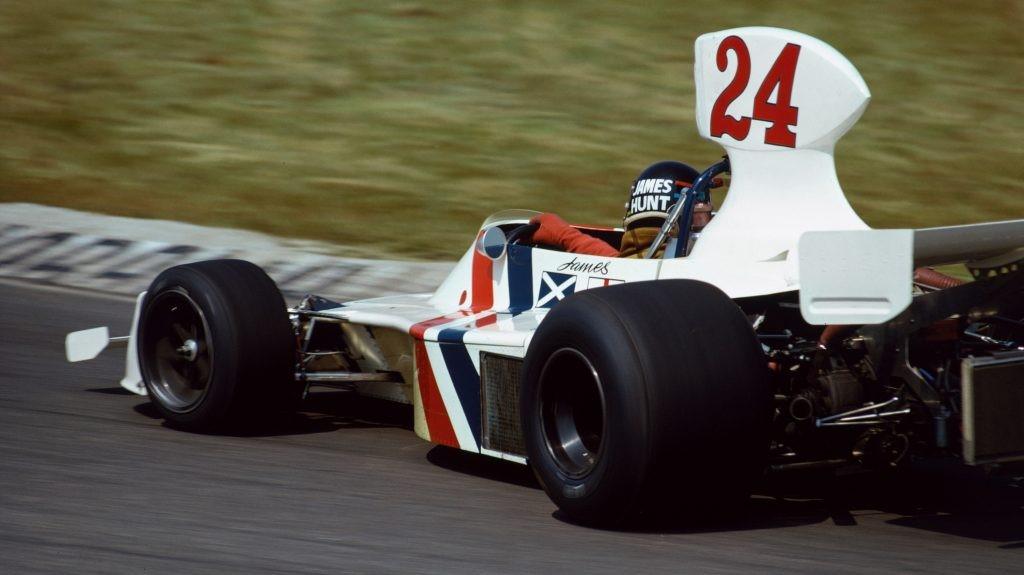
Hesketh Racing stood out in a field of corporate sponsors; their car was decorated in patriotic red, white and blue.


But it was their image off the track that brought most attention, Hesketh were the original ‘work hard, play hard team’, famous for their yacht parties and champagne lifestyle.

James Hunt with Anthony 'Bubbles' Horsley, Hesketh Team Manager, at their local British Grand Prix, Silverstone, 19 July 1975.
It's little wonder, then, that 22-year-old Lord Alexander Fermor-Hesketh proved entirely amenable when, during a society wedding, he met a kindred spirit called Anthony 'Bubbles' Horsley who suggested he set up (and pay for) a F3 racing team in order to give them both something to do at the weekends.

The Hesketh Racing Dastle F3 car in 1972 driven by James Hunt and Bubbles Horsley. Credit unknown.
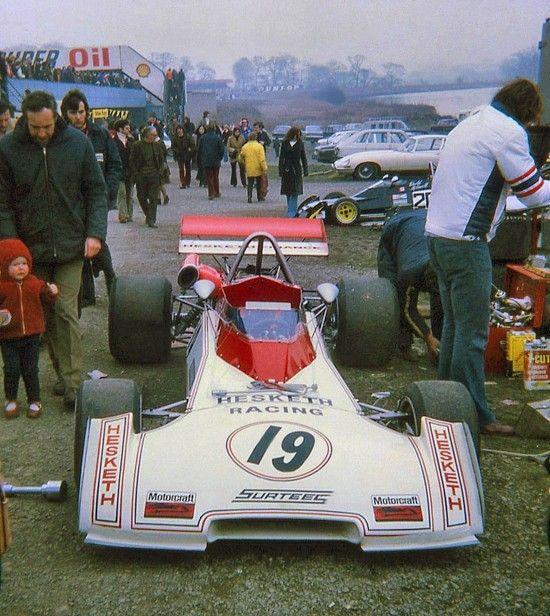
The Hesketh Racing Surtees TS14B at the Luxembourg Formula 2 Trophy 1973. Credit unknown.
So, in 1972, Hesketh Racing was formed with the large and ebullient Hesketh as 'team principal' and his best chum Horsley as its not especially brilliant 'pilota'. The duo quickly attracted a few similarly well-bred kindred spirits - the van driver was Charles Lucas, grandson of the architect of London's Albert Hall; catering was by Tom Benson, a successful Chelsea restaurateur and Christopher Simon Sykes (later a top society photographer) captured the whole jolly affair on film.
For several months, they travelled Europe's race circuits with great enthusiasm but little actual success, with the mission objective simply to have as much fun as possible.
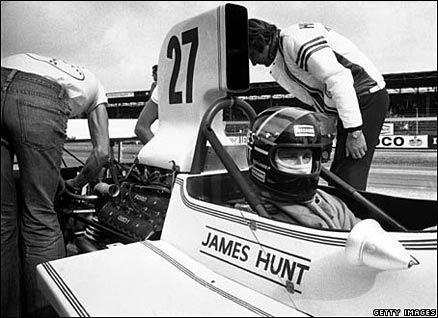
Until, that is, Hesketh met a jobless young driver called James Hunt who was struggling to find work. A fateful meeting. The dashing and mischievous ex-public schoolboy had the perfect credentials for a position with Hesketh Racing and he was taken to race alongside Bubbles in F3 and F2. Unfortunately both men had a habit of smashing up their race cars (Hunt through lack of fear, Bubbles through lack of talent).
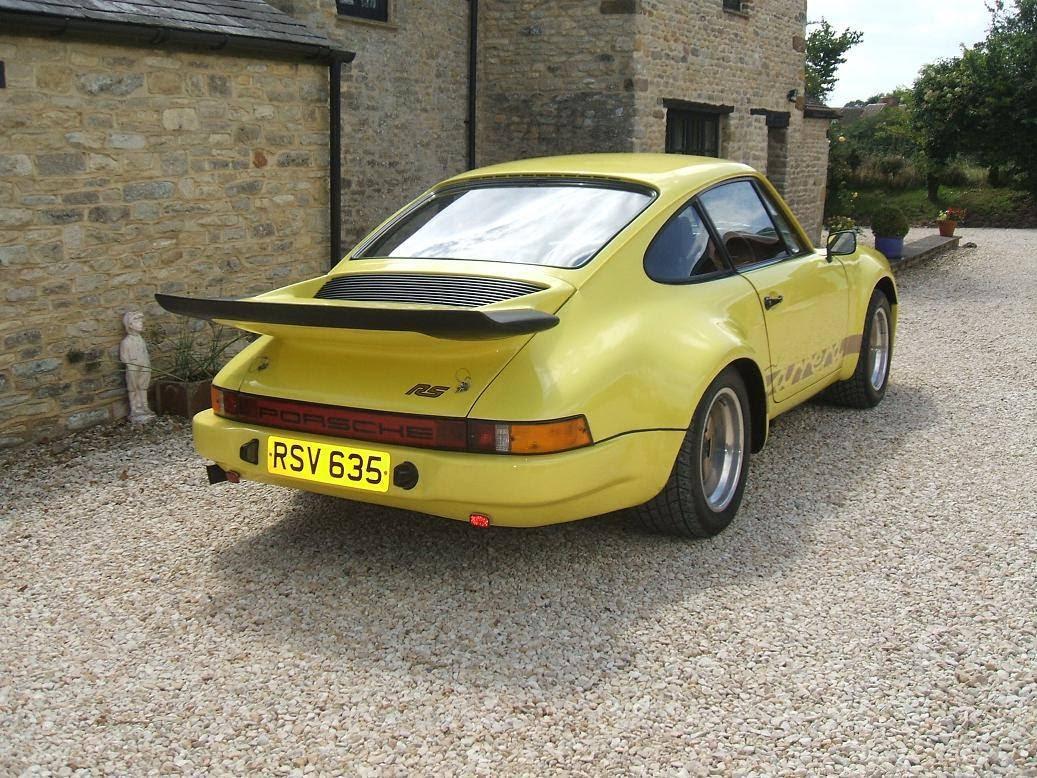

The ex-Lord Hesketh 1974 Porsche 911 semi-race car. Credit: unknown.


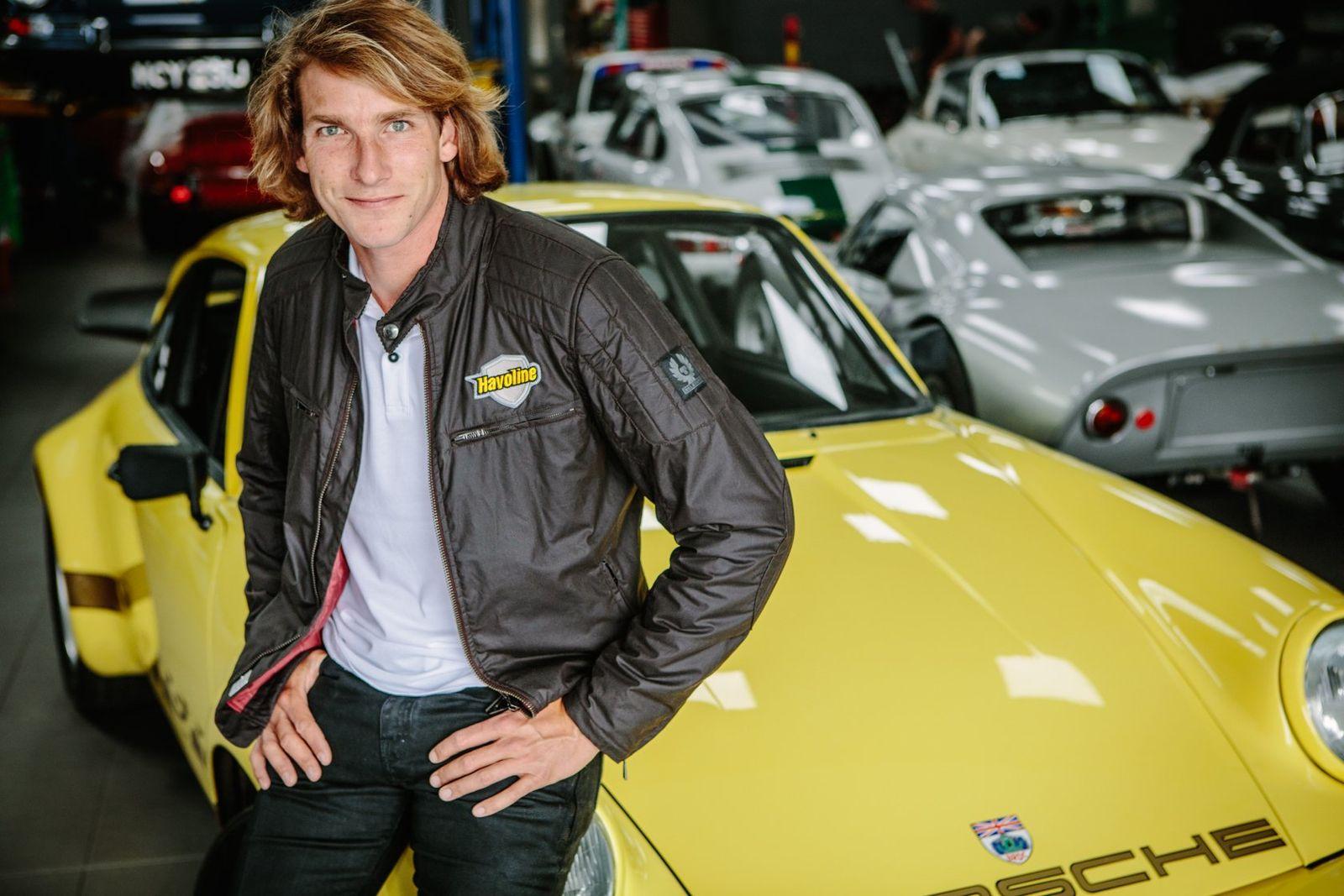
James Hunt's son, Freddie, with the ex-Lord Hesketh 1974 Porsche 911. Credit Texaco Halvoline.
The Hesketh team had a growing reputation for their playboy style, arriving at races in luxury cars, drinking champagne regardless of their results and checking the entire team into five-star hotels. The squad even had a patch specially made for Hunt's driving suit which read: "Sex – The Breakfast of Champions".
The team subsequently upgraded to F2 but a dubious bit of ‘man maths’ by Hesketh figured that racing at any level was a bloody expensive business and it wouldn’t cost him much more to step up a league and form a F1 race team to compete in the top flight. ‘In for a penny, in for a pound.’

James Hunt and best man Lord Hesketh before James Hunt wedding on October 18, 1974. Photo by Hulton-Deutsch/Hulton-Deutsch Collection/Corbis via Getty Images.
In 1974 Hesketh Racing, with Hunt as its n°1 driver, entered their first F1 race at the Spanish GP in the newly unveiled Hesketh 308, a heavily fettled version of their old March 731 F2 race car. Lord Hesketh’s philosophy was that, if you’re going to race in the World’s most cut-throat, expensive and dangerous branch of motorsport, then you might as well have a bloody good time doing it. Hunt and Hesketh installed a grand piano in the back of their pit garage for pre-race sing alongs with friends and celebrity pals. The champagne flowed at Hesketh Racing whether they won or lost.

For the 1974 Monaco Grand Prix Lord Hesketh chartered the massive Nefertiti for entertaining and the slightly smaller Henry Morgan for the Hesketh ’workers’ including James Hunt, designer Harvey Postlethwaite and team manager Bubbles Horsley. Source Hesketh Archives.
The team’s first F1 outing proper took place at the Monaco GP.

The squad chose a Rolls-Royce Corniche and a Porsche Carrera as runarounds to get them to and from the track, with relaxation taking place off-shore on Hesketh's 162-foot yacht Southern Breeze, which was suitably well stocked with champagne and good-looking women.

Lady Hesketh, Tony Horsely, 3rd Lord Hesketh, Dave Simms and Harvey Postlethwaite. Photo by James Gray/ANL/Shutterstock.
On board was driver James Hunt, team manager Anthony Horsley and up-and-coming designer Harvey Postlethwaite. Oh, how the opposition laughed back at the track, as Hesketh bumbled about in his bespoke white suit and Hunt prepared for the race by being sick as a result of nerves. They only had one car and no spare chassis but finished ninth.

Lord Hesketh's branded helicopter at the 1974 Monaco Grand Prix. Source Hesketh Archives.

Lord Hesketh’s helicopter at Monaco in 1974.
'We felt as though we'd won the race,' Hesketh recalls. The team made an immediate impression, as much for their parties as for their racing. 'We just wanted a lot of pretty girls to tour with the team,' Hesketh says. Their attitude was exemplified up by the squad's 'entertainment division' - the cocktail makers, the posh restaurateur who cooked everyone bacon butties and the pilots and ships' captains who ran the luxury yacht, Rolls-Royce, helicopter and private plane.

This light-hearted approach often overshadowed achievements on the track. 'A lot of people didn't take us seriously,' says Hesketh. During practice for the German GP, the car broke down twice on the grid. 'We got booed off by a horrible crowd,' he continues. 'They thought we were just messing about. We booed back.' Hunt finished eighth in the team's first season (ahead of either of the Ferrari drivers) and eighth the next year.
Flushed with success, the flamboyant English garagistas frequently embarrassed the established race teams with their Hesketh 308.

The car was surprisingly quick despite its limited development budget but was also unreliable, much like its n°1 driver.

James Hunt in the 308 cockpit.
Hunt finished fourth in the championship but, in the wet-dry Dutch GP at Zandvoort in June 1975, the planets seemed to align for one glorious day and he romped his Hesketh home to take first place ahead of the two Ferraris. This was to be the team's only historic and hugely popular championship race win, Hesketh Racing’s finest moment.

LAT Photographic.
45 years on we remember one of F1 racing’s greatest underdog victories, the last 23 laps of the only win of the world's biggest little racing team. The self-styled squad had entered 20 world championship races by the time of 1975 Dutch GP. But despite moderate success (including six podium finishes) they and their fast but frequently wild driver James Hunt were still far better known for their antics off the track than for their results on it. Worse still, this lack of significant success had resulted in the underdog squad becoming increasingly impoverished. If Hunt, affectionately known as ‘Superstar’ by Lord Hesketh, couldn’t start bringing in some big results there was a real danger of the money running dry.

LAT Photographic & © Sutton Motorsport Images.
Few arrived in Zandvoort expecting to see anything other than a Ferrari walkover, especially with star driver Niki Lauda rounding into imperious form. Heavy rain drenched the dune-encircled circuit ahead of the race. When the pit stops had shaken out Hunt was left in a decent lead but, despite pressing about as hard as he could, Jarier and Lauda began to whittle away at his advantage. After 30 of the 75 laps there was just eight seconds separating the white Hesketh from its pursuers - a gap that shrank even further when after several failed passing attempts Lauda was finally able to jink his way past Jarier on Lap 43. Having dispatched the dogged Jarier, Lauda stepped up his pursuit of the unfancied race leader. With such a long way still to go, it seemed unthinkable that Hunt could keep the Austrian at bay, especially when the Ferrari eased intimidatingly onto the Hesketh’s gearbox. But if anything, having Lauda breathing menacingly down his neck only served to strengthen Hunt’s resolve. Lap after the lap the Englishman kept the Ferrari driver at arm’s length, cleverly timing his moves on backmarkers to put Lauda off his stroke. On several occasions the Austrian got so close to the Hesketh that a change of lead seemed inevitable but again and again Hunt hung on and by now the chequered flag was almost in sight. As the leading duo began the 75th and final lap, Hunt clung to his improbable lead but Lauda’s 312T still loomed large in his mirrors, if not quite as close as it had previously. For the Austrian it was a case of now or never, but try as he might he couldn’t get close enough to the inch-perfect Englishman to attempt a passing move. Eventually, after 1h 46m of flat-out racing, Hunt crossed the line 1.06s ahead of his highly-fancied rival to secure his maiden F1 triumph. Against the odds Hesketh Racing, a team formed for the sole purpose of having fun and who had arrived at the highest echelon of racing almost by chance, were GP winners. Cue scenes of unbridled celebration in the pit lane, not least from the squad’s charismatic benefactor…
“On top of every (sand) dune were just waves, waves and waves of Union Jacks,” recalled Lord Hesketh of Hunt’s lap of honour in Gerald Donaldson’s renowned Hunt biography. “It was a wonderful feeling to know that those people, who had travelled with us all the way around Europe and had seen frustration after frustration, finally saw the result they wanted.” Hunt, flanked by Lauda and third-place finisher Regazzoni, had become England’s first GP victor since 1971. But more significantly James felt that he’d now completed his education as a driver. “I could not have had greater pressure than I did in that race,” he’d explain later. “I lacked experience leading races, which is why I cocked up a couple of times earlier than year. But for once I didn’t make any mistakes and, after that, it became easier.” Little wonder then that Hunt, world champion the following year, referred to the '75 Dutch GP as the most important race of his career.
The post-race celebrations began at the circuit in Holland and ended some time the following morning in one of the lakes on Hesketh's estate in England. 'I can't remember much about that one,' says Hesketh.

Hesketh team at the pit lane.
But the team was never able to capitalise on this success, trouble was brewing. As the saying goes, ‘a candle that burns twice as bright burns for half as long’, Hesketh knew he could not keep funding the team for ever but negotiations to find a sponsor fell through.


The Penthouse sponsored Hesketh 308D, 1976.

A 1976 Hesketh 308D at Donington on 7 March 2013.

Model and Penthouse Pet, Suzanne Turner pictured beside racing driver Guy Edwards in London on 11th May 1976. The likeness of model Suzanne Turner is emblazoned on the front of the car. Photo by United News/Popperfoto via Getty Images/Getty Images.

Model Suzanne Turner sits aboard the Guy Edwards driven n. 25 Penthouse Rizla Racing Hesketh 308D Ford Cosworth DFV V8 which is adorned with her image on the cockpit as part of the livery during the launch of the Penthouse Rizla Formula One racing team on 11 May 1976 at London, United Kingdom. Photo by Keystone/Hulton Archive/Getty Images.

Guy Edwards, Hesketh, at German Grand Prix, Nurburgring, in 1976.

End of an era. ... The fabulous Hesketh 308 was mothballed. The team that offered hope and cheer, faded almost as quickly as they had arrived.

Formula One World Champion James Hunt is presented with a golden helmet by Lord Hesketh in 1976. Photo by PA Images / Alamy Stock Photo.

James Hunt moved to McLaren and won the Formula 1 Driver's World Championship in 1976.
With Hesketh unable to keep the team running, Hunt signed for McLaren and won the 1976 drivers' world championship in his first season.
'We sort of struggled on for two years,' Hesketh says. 'The trouble is after you've become used to podium finishes, it all becomes a bit depressing.'
But, just as the fairytale seemed to have come true despite those successes with their star driver James Hunt, sponsor-free Hesketh soon ran out of F1-style money. The operation was eventually sold on to the Walter Wolf team.

Divina Galica of Great Britain sits aboard the n. 14 Olympus Cameras Hesketh 308E Cosworth V8 as Lord Alexander Hesketh sits astride the front left tyre, at the team launch on1st January 1978 at the Silverstone Circuit in Towcester, Great Britain. Photo by Getty Images.
In 1978 they were forced to seek a sponsor, ironically ending up with a Japanese camera company who insisted they use a new driver, Divina Galica, previously better known for her downhill skiing. The rest, of course, is history - the sort that can never, ever be repeated.
A company called Retro GP now owns the Hesketh Racing trade marks.
Lord Hesketh entered politics. His most prominent role since has been in it. 'I was in it seven years. Although some of it was extremely frustrating, I wouldn't have missed it for the world.' From 1986 to 1993 he worked first under Thatcher ('the most outstanding person I ever worked with') at the Department of Trade and Industry and then as chief whip in the Lords under John Major. After the reform of the Lords he decided not to stand for re-election. He is, however, still in touch with Thatcher, 'I occasionally take her out for lunch.'
Hesketh spends most of his time running his 9,000-acre estate alongside his wife (they have three children) and managing his various business interests.
He can't hide his affection for Hunt, who died in 1993. 'We drifted apart. It was really only when he became a journalist and stayed here for Silverstone that we drifted together again. I am really pleased that happened before he died.' And with that, he can't suppress a mischievous smile. 'We were,' he said, 'more like a band than a racing team.'
With all due respect to his detractors of today and of the time, Lord Hesketh is really a great character. In an unsuspected era, when F1 was a melting pot of epic figures, this plump English aristocrat did something absolutely revolutionary.
Founding a team at the age of 23, using much of the money inherited from his late father, was an act that could be called clumsy. But Lord Thomas Alexander Fermor-Hesketh, Hesketh’s third Baron, has always been a dreamer who never wanted to give up his passions. On the contrary, he has gone to great lengths to achieve his objectives at the cost of being an incurable and romantic naive in the eyes of the most experienced. He stopped attending university to give his soul and body to that extravagant adventure and enter a world made even back then of great builders, such as Ferrari and Lotus. A universe less selective and professional than the present one but light years away from what was the disenchanted philosophy of the young baron. Lord Alexander liked the good life and certainly did not limit himself to showing his bizarre tastes in public. Despite appearances, Hesketh put together a high-quality package to take the big leap into the world championship Circus. And, contrary to what one might think, at Hesketh Racing you worked and a lot because you don’t win by chance, much less in Formula 1, even in that of many years ago. Pilot was the 25-year-old James Hunt, whose photos of the time portrayed him in the cockpit, like so many other drivers of that time, with the unmissable cigarette hanging from a corner of his mouth, habit taken at the age of ten. The young and eccentric Lord and the young and wild driver: an explosive mixture in a world, that of F1, which was trying to give itself a highly professional connotation on the wave of arrival of important sponsors. Instead, the participation of Hesketh Racing at the GPs was absolutely irreverent due to the presence of beautiful women and flowing champagne. In this, Lord Hesketh paid no heed to expenses, perhaps even in an attempt to overshadow his clumsy-looking appearance that contrasted with that of his handsome, damned and lady killer driver.
James Hunt had the same extravagant qualities as his boss and perfectly embodied the unconventional philosophy of Lord Alexander. He was the classic playboy with "beatnik"-style hair, who loved reverly in the evening. Moreover, at the moment when he got behind the wheel, the Briton became a very tough customer and combined that dose of genius and unruliness into a mix of healthy Gascon madness that in the 70s was needed to be able to race at three hundred kilometers an hour in cars still a long way from being safe.

Lord Alexander Fermor-Hesketh (left) pictured with English Formula 1 racing driver Rupert Keegan sitting in the driver’s seat of a Hesketh 308E racing car featuring Penthouse Rizla Racing livery, in London on 9th March 1977. Photo by United News/Popperfoto via Getty Images/Getty Images.
In 1977 various drivers were at the wheel of the two 308 and 308/E. Among them the Austrian Harald Ertl, the Mexican Héctor Rebaque and the British Rupert Keegan and Ian Ashley.

Rupert Keegan, F1 Penthouse/Rizla Hesketh 308, in 1977.

1977. The playboy that was Rupert Keegan.
More than anything else in those years the Hesketh stood out for its particular livery, painted in the colors of the famous Penthouse adult magazine: a gesture that, perhaps, represented the last real theater hit of the eclectic Lord Alexander in the golden circus of the biggest formula.
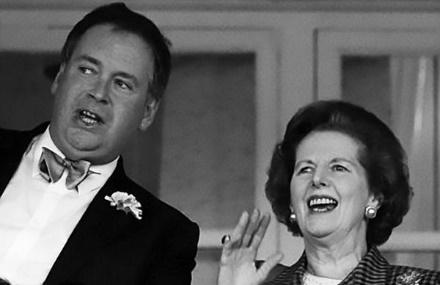
Lord Hesketh with Margaret Tatcher.
In 1978 leaves the scene, after only five years and 52 Grand Prix races, the loudest, the most cheerful, weird and passionate team that F1 has ever known. Later, after founding the catastrophic Hesketh Motorcycles to build the two-wheeled Aston Martin and being forced to sell the family estate to pay off huge debts, Hesketh was dazzled by the personality of Margareth Tatcher and devoted himself completely to political career in the Conservative field, reaching important positions.

Hesketh Racing, 2016.
“The biggest little racing team in the world. Racing for Britain, racing for you”.

Thank you Lord Hesketh for those fantastic years in F1, we will always be Hesketh Racing fans.
Zandvoort 1975: Hesketh Racing's only Grand Prix win. By Simon Arron. June 22nd 2020. Forty-five years ago today, a privately funded Formula 1 team notched up its only grand prix victory by the Dutch coast. We look back at James Hunt's winning drive with its patron, Lord Hesketh.

Hunt's slick-tyred Hesketh was the car to beat on a drying Zandvoort circuit. Grand Prix Photo.
Spoilt by the cumulative successes of such as Jim Clark, Jackie Stewart, John Surtees and Graham Hill through the 1960s, British motor racing was in the market for a fresh talisman.
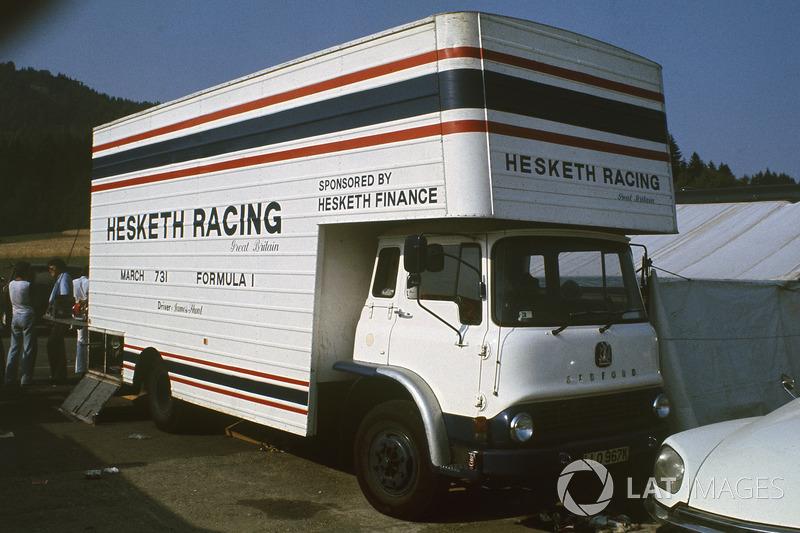
Hesketh racing-team’s truck, 2-axle Bedford TK transporter, in the paddock at the 1973 Austrian Grand Prix. Credit unknown.

Hesketh 731 with James Hunt in 1973.
Stewart had notched up a record-setting 27th grand prix victory at the Nürburgring in August 1973, en route to becoming the sport’s eighth British world champion in 12 seasons, but there had been nothing of that calibre since.

James Hunt‘s 1974 Hesketh 308 F1.
A lanky former Mini racer from Belmont, a village in Surrey’s stockbroker belt, James Hunt hadn’t been the most obvious candidate to fill the breach. He’d been quick through his career in junior single-seaters, but also a touch accident-prone. Following an acrimonious separation from the works March Formula 3 team in the first half of 1972, Hunt had agreed – following a meeting in the paddock at Chimay, Belgium – to continue in F3 at the wheel of an unfashionable Dastle Mk9, entered under the Hesketh Racing banner in deference to sponsorship provided by Alexander Fermor-Hesketh, 3rd Baron Hesketh. Towards the campaign’s end, Hunt impressed with a stirring drive to third place in the final round of the British F2 Championship at Oulton Park, his year-old March 712 beaten only the latest factory 722s of Ronnie Peterson and Niki Lauda.

23 years old and having just launched his own F1 team, Lord Hesketh in the pits at the Monaco Grand Prix in 1973. Source National Motor Museum.
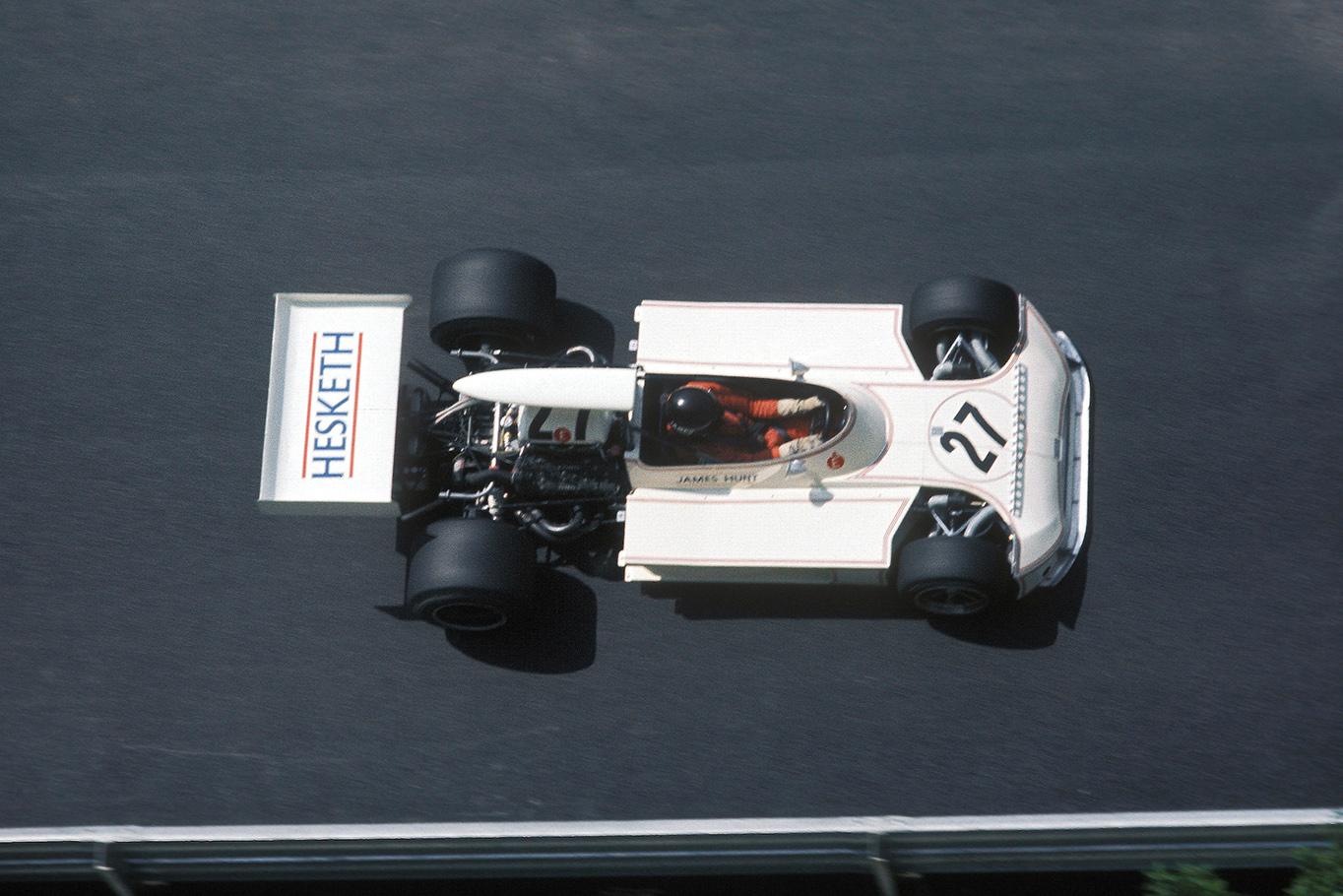
Hunt makes his World Championship debut at Monaco in 1973. Grand Prix Photo.
For 1973 Hesketh originally intended to run Hunt in F2 at the wheel of a customer Surtees TS15 – and the programme started brightly, the Englishman running as high as third in the European Championship opener at Mallory Park before his suspension collapsed. He impressed again the following weekend, finishing third in the Race of Champions at Brands Hatch on his F1 debut, at the wheel of a hired Surtees TS9B. Two months later he would make his world championship bow in Monaco, scene of his messy F3 divorce just one year beforehand, at the wheel of Hesketh’s freshly acquired March 731. He finished ninth, precursor to an eye-catching run of results through the summer – sixth at Paul Ricard, fourth at Silverstone, third at Zandvoort – and a mature pursuit of winner Ronnie Peterson’s Lotus 72 in the seasonal finale at Watkins Glen.

Harvey Postlethwaite.
To the wider world, Hesketh Racing appeared to be in motor racing to have fun – even in F2, its paddock enclave had been noted for its conspicuous consumption of champagne and caviar – but there was serious engineering talent at its core, spearheaded by Harvey Postlethwaite, and in Hunt it had found a driver of parallel ability and ambition.

Lord Hesketh with James Hunt and the new Hesketh racing car. Photo by ANL/Shutterstock.
For 1974 Postlethwaite developed the Hesketh 308, the team’s first eponymous F1 chassis. Hunt retired on its debut in the South African GP, but scored a resounding victory one weekend later in the non-championship International Trophy at Silverstone. It was achieved the hard way, too, the Englishman having dropped from pole position to the back of the pack due to an overheating, slipping clutch on the opening lap, before launching an impressive recovery. In subsequent world championship races, there would be ample promise and three third-place finishes, but no more.

Lord Hesketh with Hunt, team manager Bubbles Horsley and Postlethwaite at Monaco in 1974. Photo by Bernard Cahier/Getty Images.
In the uprated 308B, Hunt began the following season on an encouraging note – leading in Argentina before running wide, and eventually having to settle for second behind Emerson Fittipaldi. He was sixth in Brazil, but that preceded a string of five straight retirements (though he had led in Spain, before sliding off on oil). He had also dominated the International Trophy, leading from pole until his engine blew. “The reason for that was rather unusual,” says Lord Hesketh. “James was so consistently quick through the original sweep at Woodcote and it was such a long corner, that the oil came off the crank. I was amazed they could find that out and the guys at Cosworth said they’d never seen it before, but James was an absolute Woodcote maestro. He was one of two exceptional drivers I saw though there; the other was Jim Clark…”
Prior to F1’s arrival in Zandvoort for the Dutch GP, few had given the Cosworth-powered teams much chance. Ferrari had dominated in 1974 and, in the hands of Niki Lauda and Clay Regazzoni, its flat-12 312Ts were again expected to have the upper hand. They duly annexed the front row, with Hunt best of the rest ahead of Jody Scheckter’s Tyrrell.
“That weekend there hadn’t been a cloud in the sky through Friday or Saturday,” Hesketh says. “It was clear blue and blazing hot – perfect conditions. On Sunday morning, though, it rained remorselessly.”
Local noise restrictions meant it wasn’t possible to run the then-traditional Sunday morning warm-up at Zandvoort, but the change in weather led to a delayed start and the organisation of a brief pre-race practice session so drivers could acclimatise.
Hesketh: “one problem for us was that our chief engineer Harvey Postlethewaite had returned home to work on our new 308C, which was due to begin testing in a few weeks. Our guys looked at the sky and the track and wondered what to do, but it was felt that trying to revise the set-up might be fraught with difficulty – and we could also see clear skies farther to the north, where the weather was coming from. Because Holland is by the North Sea, it’s just like being in Yorkshire or Norfolk. You could see a bright horizon, so we decided not to interfere with the car – especially as we didn’t have Harvey on hand. At Ferrari, I think Mauro Forghieri and his merry men added a bit of wing front and rear.”

James Hunt makes an early pitstop driving the n. 24 Hesketh Racing Hesketh 308B Cosworth V8 DFV during the Dutch Grand Prix on 22nd June 1975 at the Circuit Park Zandvoort in Zandvoort, Netherlands. Photo by Grand Prix Photo/Getty Images.
What happened next, though, was a consequence of events during the most recent rain-affected race, in Monaco. “That was absolutely crucial,” Hesketh says. “James had a theory that the dry line on a mostly wet track offered more grip than people realised and we brought him in earlier than others for slicks that day, though we screwed up the stop and it took more than 20sec longer than it should have done. He consequently had to push pretty hard and eventually slid off into the barrier, but it was the first time he’d had chance to put his theory to the test – and he’d been lapping quickly. At Zandvoort, the rain had just about stopped by the time they did the warm-up lap, so we had the slicks out, ready in the pit lane.”

Lauda leads the field through the spray. Motorsport Images.
Lauda led away, with Scheckter vaulting to second ahead of Regazzoni and Hunt, but the latter was in the pits by lap seven, to take on a set of slicks. “Everyone else looked on in amazement,” Hesketh says, “but we were confident and, the key thing, so was James. There’s no point making a technically brilliant decision if the driver disagrees with it.”

Jochen Mass (foreground) and Tom Pryce attempt to get to grips with the slippery conditions. Motorsport Images.
After Ferrari pitted Lauda and Regazzoni on laps 13 and 14 respectively, Hunt led.

Hunt, Lauda and Pryce at the 1975 Dutch Grand Prix.

Lauda overtakes Price.

Niki Lauda following James Hunt.

Hunt soaks up the pressure. Motorsport Images.
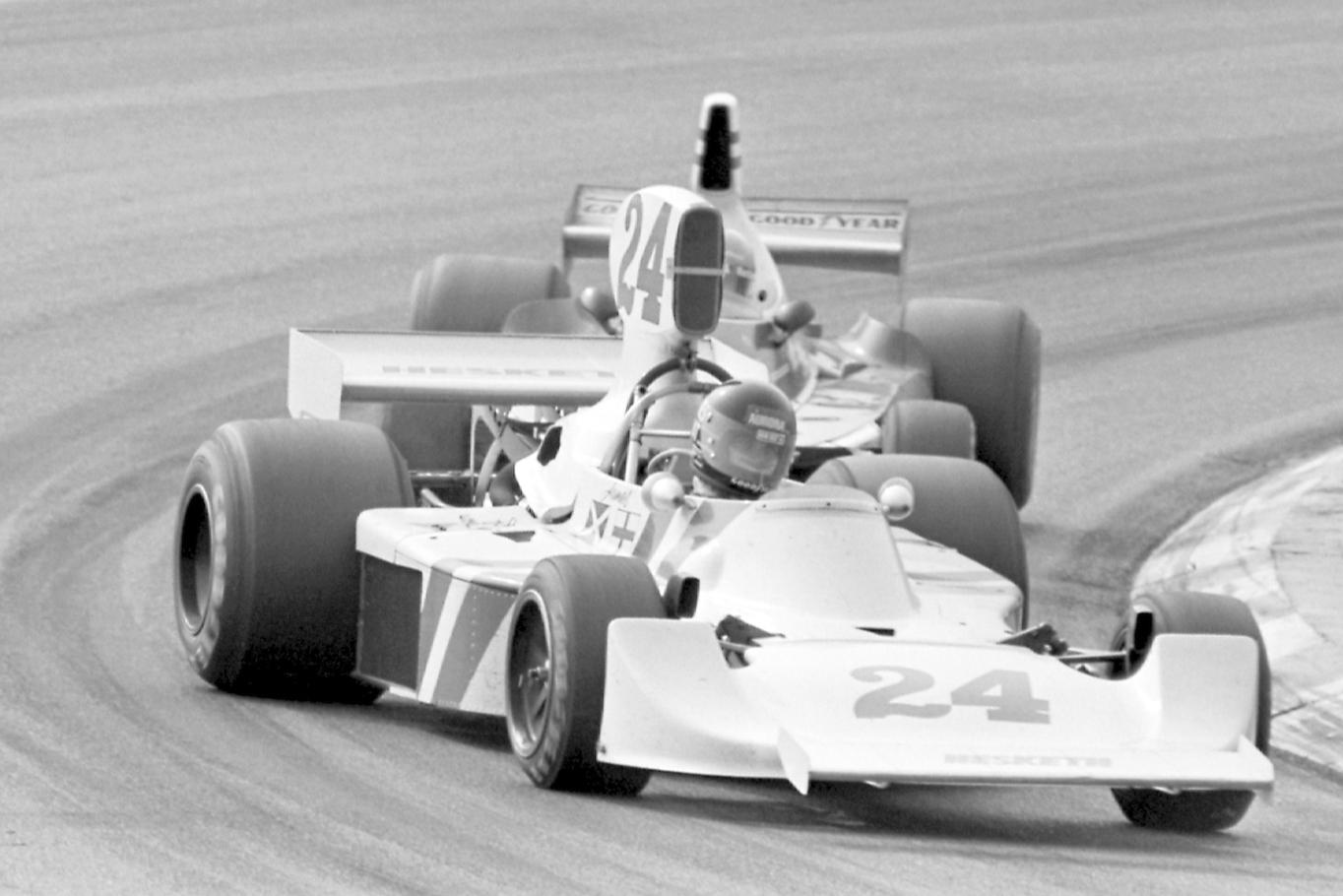
Hunt fends off Lauda in the closing stages of the race. Grand Prix Photo.
“Once he was in front, the test was whether he’d be able to hold off the Ferraris to the end,” Hesketh says. “You have to remember that we had no TV monitors back then, so you couldn’t see what was going on, the commentary was in Dutch but inaudible anyway and there were no radios. The only time you saw the cars was when they passed the pits, but those at Zandvoort were towards the end of a very long straight – so we could watch them for a short while. At first there was just a white dot looming into view, followed by two quick red dots. Slowly, slowly we could see them getting closer and we were on tenterhooks wondering whether Niki would be able to challenge. Only during the final two laps did I get the impression that he’d decided he couldn’t make it. He hadn’t backed off, but I sensed he’d lost the belief that he could get through.

The famous victory at Zandvoort in 1975. A jubilant Lord Hesketh waits for James as he comes around to the pits after successfully winning the 1975 Dutch Grand Prix by one second. Source: Crash.net.
The tension lasted a long time – and I wasn’t convinced we would win until the chequered flag came out”.

Lord Hesketh jubilant at James winning the Dutch GP in 1975. Credit unknown.


“It wasn’t the same as winning your first race, as we had at Silverstone the year before, but victory came as a relief because our lack of results had been driving us all towards a nervous breakdown. The real sensation of success came afterwards. Zandvoort is quite unusual, of course, because it is surrounded by dunes – and there were lots of little encampments scattered around, with people waving Union Jacks and Hesketh teddy bears [the team’s motif]. They didn’t all rush off to catch the ferry home but stayed on to celebrate. In a sense, going around the track afterwards was the best bit.”
James Hunt's last Hesketh F1 car sells 45 years after its final race. By James Elson. June 10th 2021.

Hunt's Hesketh 308C has sold for a 'high six-figure sum". Duncan Hamilton ROFGO.
The very last Hesketh F1 car that James Hunt drove before moving to win the drivers’ title with McLaren has sold for “a high six-figure sum”, according to its seller, the historic car dealer Duncan Hamilton.
The radical 308C, designed by Harvey Postlethwaite and driven by Hunt to fourth and fifth at the last two races of ’75, represents one of the great F1 cases of ‘what could have been’.
Due to a lack of finance, this very car – the 308C chassis no1 – was sold to the Wolf-Williams Racing team – whilst the Hesketh team (with a new sponsor) staggered on with an updated version of its old challenger in ’76.
Speaking to Motor Sport about the car, the team’s original owner Lord Hesketh said team and machine represented “a belief in a kind of English genius. A country that’s got real abilities.”
The motley Hesketh crew, funded by its eponymous owner and led by his friend Bubbles Horsley, had already taken its first win earlier in ’75 with Hunt at Zandvoort, in only its second full season.

James Hunt on the grid in the Hesketh 308C at Monza ’75. Duncan Hamilton ROFGO.
The winning car that day, the Hesketh 308B, was also designed by tech prodigy Postlethwaite. As explained by Hesketh, the team was looking to kick on in its own inimitable fashion. The team felt that first win had been long overdue, and invested the knowledge accrued in the new 308C.
“We were pretty pissed off by ’75 because on a quick track we were the only car that was really competitive with the Ferrari 312B,” he says.
“We were pretty excited because we’d already paid the price, we learned from all the mistakes, bits falling off like the gear stick which came away in James’ hand when we won.”
As Hesketh explains, its successor, the 308C, was a result of an idiosyncratic relationship nurtured between driver and designer.
“James was able to describe what was happening in the car in a way that Harvey found wholly comprehensible and was able to react to in a positive way.”
The result of that reaction was the Hesketh 308C.
The car has several unusual design features, including being one of the few cars on the grid in ’75 to not have an airbox, unconventional rear suspension set-up and also have its radiators right up against the rear wheels. Lord Hesketh says the freedom team members were afforded resulted in greater lateral thinking towards design.
“These processes happen when the operation is not entirely being run as a business. In those days, there were teams that were not dependant on being a business,” he says.
“You have some teams that are run by control freaks, but we were at the opposite end of the spectrum. The great thing about not having a sponsor, everyone can get on with their job and didn’t have to worry about anything!”
Hesketh went on to detail what made the car unique.
“It was the ultimate expression of a small F1 car,” he comments. “It was the first one to have major bits of carbon fibre as part of its actual chassis.”
“It was also the first to use rubber suspension at the rear [mounted on rockers]. This was done with Malaysian Rubber Company.”
The team’s chief engineer, Nigel Stroud, explained to Motor Sport in his and the team’s typically relaxed fashion how he came up with the components he contributed.
“I did the front wing and the front brake ducts. Harvey absolutely hated the latter – because he was Harvey! He didn’t do them,” Stroud says laughing. “They were just knocked up from a bit of aluminium in an afternoon”.
In keeping with the team’s quirky reputation, Stroud is laidback in the extreme as to explaining the inspiration behind the design.
“Oh I don’t know, it had to have a front wing!” he says. “There were some horrible suspension bits sticking up in the air [at the front] that were seriously un-aerodynamic. So I decided to bung a couple of brake ducts in front of them, which I thought was quite sensible.”
As Hesketh could no longer afford to fund the team beyond ’75, the small squad needed a sponsor. It ploughed on with the car design anyway in the hope that one would be found.
“It was a progression but you had to do it, because you had to assume we would get the finance from somewhere,” Hesketh says.

Hunt competed in two championship races with the 308C and one non-championship race pictured here – the Swiss GP at Dijon. Duncan Hamilton ROFGO.
“If we hadn’t, we’d have looked pretty silly with the old car!”
Asked if he thought the Hesketh team might have been able to go on to more success with the 308C in ’76, he replies: “I dunno, it might’ve been a turkey!”
Though Hesketh himself insists he’s unsentimental, what the car represents for him and the key members of that team is the end of a racing dream. The rock ‘n’ roll F1 band would have to be broken up.
“What what was going to happen was that two people would have to go – and that was James and Harvey,” he says.
“For their careers and for money. James had quite a lot of world championship points but probably made less money than anyone else contemporaneously by quite a wide margin.”
Stroud is more reflective in contemplating what might have been.
“I think we gained a lot of respect from the other teams, in our first year [with their own car],” he says. “It was just a shame it didn’t continue.”
Videos



Comments
Authorize to comment